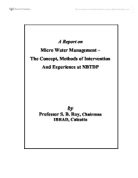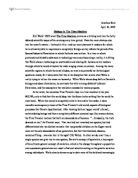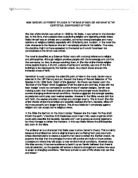Micro Water Management -The Concept, Methods of Intervention And Experience at NBTDP.
A Report on Micro Water Management - The Concept, Methods of Intervention And Experience at NBTDP by Professor S. B. Roy, Chairman IBRAD, Calcutta Introduction The last half of the 20th century was characterised by unprecedented changes and irreversible trends in natural, technological, social, economic and political factors that have affected human life in radical ways. This when combined with population explosion, urbanisation, industrialisation and economic development exerted high pressure and demand on natural resources, most notably on water resources. We need to have an efficient and effective management of our water resource as its demand has increased with the rise in the population growth and the rise in pollution. Firstly comes the policy support and legislation of the country, the attitude and capacity of the state, the local bodies and the local self government to operationalise the rational use of water. Different stakeholders are involved in the different aspects of the water management like that of irrigation, domestic and industrial supply, flood control and so on. Secondly, the interrelationship between the land and water should be viewed as SYSTEM and water as part of the planning process. Thirdly, research and development programmes need to be undertaken on a range of activities like that of water conservation, water quality management, pollution
Biology in The Time Machine.
Jonathan Katz April 10, 2003 Biology in The Time Machine H.G Wells' 1895 novel The Time Machine, serves as a striking look into the hotly debated scientific issues of his contemporary time period. Even the most obvious clue into the novel's events- the book's title-and our main character's medium for which he is ultimately able to experience a completely foreign world, reflects the period of the Second Industrial Revolution in which the book was written. In a time in which previously unthinkable advances in technology were soon becoming a reality, it is fitting that Wells chose a technology so unattainable and alluring for humans as his medium through which he could articulate his wide-ranging views on science. Among the many scientific regions to which the novel alludes, no area is as powerful as the biological questions raised, for it does seem that this is the discipline that covers what Wells is really trying to tell us: his views on humanity. While Wells shows deep faith in Darwin's biology and ideas of evolution, he contrasts this with a strong disbelief in Social Darwinism, and the assumption that evolution necessarily means progress. In the novel, the nameless Time Traveler rides in a time machine to the year 802,700, only to find that this world deep into the future looks nothing like the world he once knew. While this world is completely alien to him and to
Enzyme-Linked Immunosorbent Assay or ELISA as it is more commonly known is an enzyme immunoassay (EIA), which is one of the most widely used applications of monoclonal antibodies.
ELISA Enzyme-Linked Immunosorbent Assay or ELISA as it is more commonly known is an enzyme immunoassay (EIA), which is one of the most widely used applications of monoclonal antibodies. Immunosorbent assays, as the term suggests, involve adsorption of either the antigen or the antibody to a surface, in most cases the bottom of a plastic well. The ELISA is used to detect and amplify an antigen-antibody reaction. It is the most basic test to determine if an individual is positive for a selected pathogen. It screens everything from drugs to the AIDS virus in humans. ELISA techniques have advantages of specificity and sensitivity when compared with more traditional tests. It is generally a cheap and simple method. The ELISA is based on antibody recognition of a particular antigenic epitope. Monoclonal antibodies can be cross-linked to one of nine different enzymes and used in the ELISA. Anti-rabbit immunoglobulin is conjugated with alkaline phosphatase (1:3 by weight) by addition of glutaraldehyde. Glutaraldehyde is a bifunctional cross-linker used to join the enzyme to the antigen or antibody. Maleimide derivatives can link two separate protein molecules together, one through an amide bond and the other through a thioether bond. Based on the principle of antibody-antibody interaction, the ELISA technique allows for easy visualization of results and can be completed
How does Well's present religion in the 'War of the Worlds' novel and what is the significance of this?
HOW DOES WELLS PRESENT RELIGION IN 'THE WAR OF WORLDS' AND WHAT IS THE CONTEXTUAL SIGNIFICANCE OF THIS? The War of the Worlds was written in 1898 by HG Wells. It was written in the Victorian era. At this time, many people were questioning religion and exploring atheist ideas. Wells himself was an atheist and a socialist, so he had strong ideologies and many opinions on religious beliefs; especially with Christianity and Judaism. In the novel the main character is the Narrator who isn't completely atheist in his beliefs. If he were, the storyline might not have appealed to the reader as it would have been too controversial at the time it was written. The novel is classified as a Science-Fiction story with a strong reference to religion and philosophies. Although religion provides people with the knowledge and comfort that someone, i.e. God, is always watching them, in The War of the Worlds religion drove people insane. A church, a place of safety and worship, was one of the first buildings to be destroyed by the Martian attack. As a result chaos ensued this indicated a loss of faith. Darwinism is used to portray the scientific point of view in the novel. Darwin was a scientist in the 19th Century and put forward the theory of Natural Selection of The Species in his 1859 book 'Origin of the Species'. His theory was based upon the 'Survival of the Fittest' which suggested of





